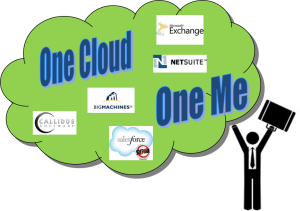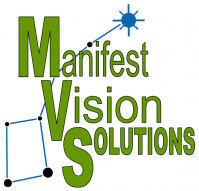Why Transform: A picture is worth a thousand words
March 27, 2012 2 Comments
Here’s an example.
What does this represent to you?
• Why transform?
• Who will benefit?
For me this is an example of a manifest vision. The goal is to create a picture in your mind of why to transform and what success looks like. What do you see? For more on why you might want to have a manifest vision see the following: http://blog.manifestvisionsolutions.com/2012/03/07/the-value-of-vision-and-solution-description/
In the example you are part of a very successful startup company. To get going you made extensive use of cloud computing or Software as a Service (SaaS) solutions. It was great! But over time, your salesreps started to complain (salesreps never do that, do they?); they had to go too many places with different logins to get what they needed to know. It was taking way too long. And it didn’t seem consistent to them; what they had quoted didn’t match the win probability values on the opportunity, they could match their configurations and quotes but couldn’t find quotes they thought they had submitted as orders. And you noticed that your salesreps were spending way more time making sure their commissions were accurate instead of being out there selling. Does any of that seem familiar to you?
For this example, I might respond to the questions above like this:
Why transform? To increase salesrep productivity and increase revenue; get the reps to spend more time selling!
Who will benefit? Salesreps, sales operations, sales management, order management, shareholders
Success looks like a happy productive salesrep.
Obviously there’s more to it. People will have many perspectives, so depending on who you’re talking to you might get slightly different answers to the questions. But that’s OK; you want people to see what’s in it for them at the vision level.
Lots of people have commented on the importance of having a vision. Here are some observations I found interesting: 5 Reasons Why Vision Is Important http://www.youtube.com/watch?v=St4yaNJkdDQ
Vision has lots of applications; it isn’t limited just to the overall company reason for being. It is an effective tool in any cross functional transformation program where many people need to internalize a common purpose for change.
What do you think of the example? Will people will be able to see why to transform? Will they know what success looks like? I’ve seen a vision like the one in this example used on a program. It was understood by everyone; people were empowered and inherently knew what to do and why. No one was talking about how we couldn’t do something but about how we could and would get things done. It was a productive environment with rapid decision making done at the right level. And the results were spectacular, a global change on time and on budget which was rapidly adopted. Not bad for a little upfront investment!
Do you have a transformation program that could use a picture that is worth a thousand words, a manifest vision?
BTW: I do not endorse or oppose any of the companies whose logos do or do not appear in the example. They are just the ones I thought of today.
© Ellen Terwilliger 2012


